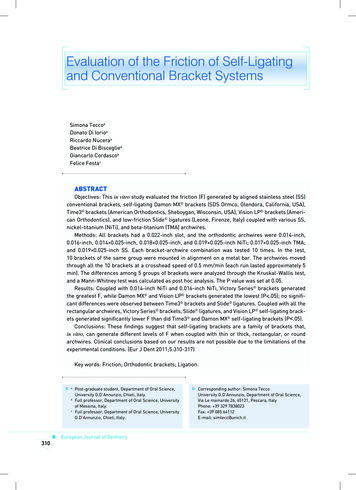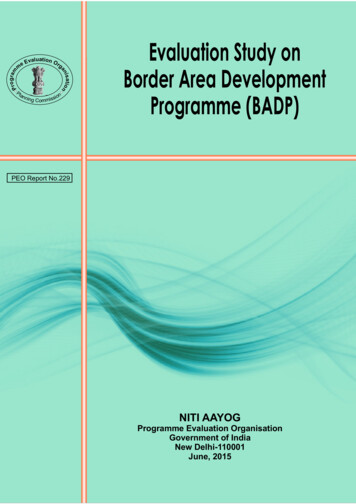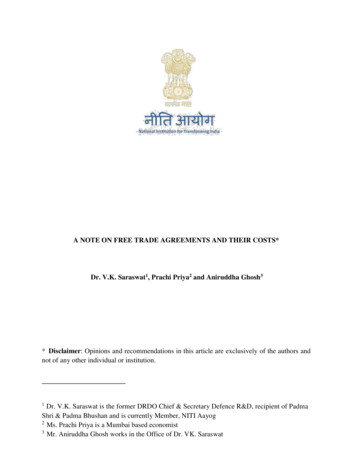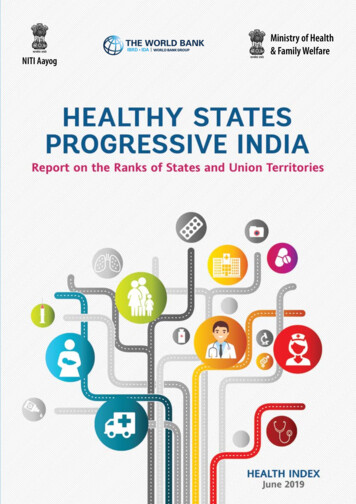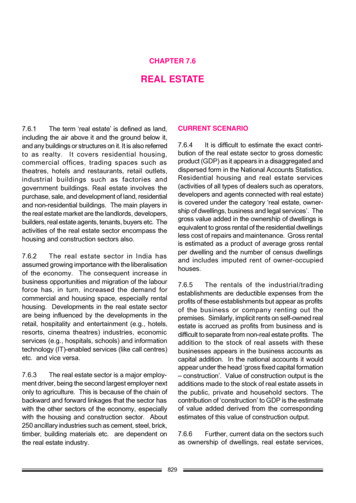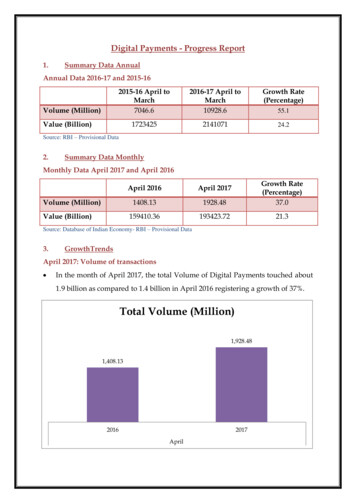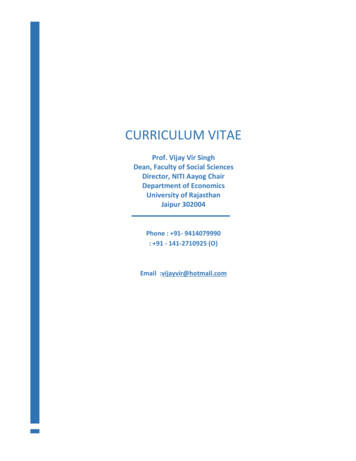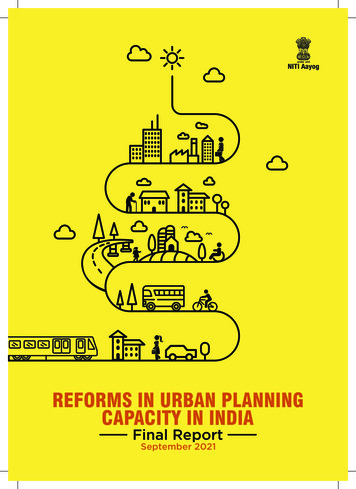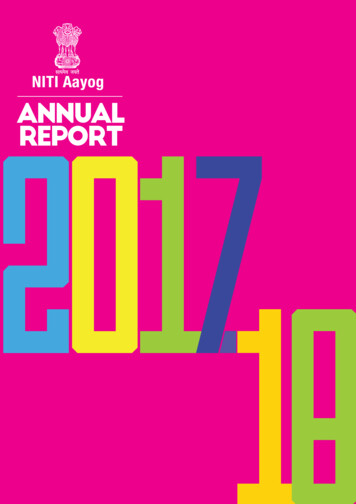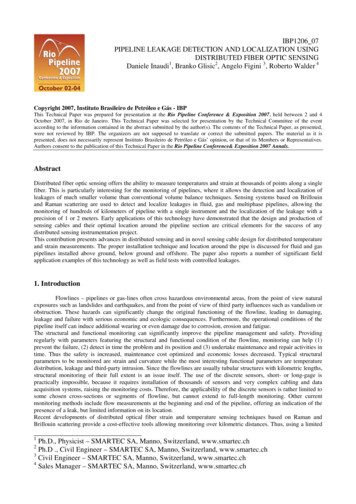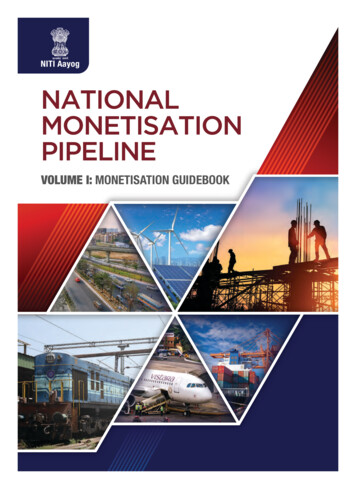
Transcription
NATIONAL MONETISATION PIPELINENATIONALMONETISATIONPIPELINEVOLUME I: MONETISATION GUIDEBOOK
NATIONAL MONETISATION PIPELINEVolume I : Monetisation GuidebookGOVERNMENT OF INDIANEW DELHI
PrefaceInfrastructure is critically linked to growth and economic performance. Benefits of higherinvestment in good quality Infrastructure manifest in the form of increased employmentopportunities, access to market and materials, improved quality of life and empowermentof vulnerable sections. Recognizing the importance of infrastructure, the Government hascontinued its focus on sustaining and stepping up the pace of infrastructure investment.Investment led growth is therefore, central to the economic agenda of the Governmentand one of the pre-requisites of Investment led growth is capital and asset recycling. Assetrecycling and monetization is the key to value creation in Infrastructure by serving twocritical objectives, unlocking value from public investment in Infrastructure and tappingprivate sector efficiencies in operations and management of infrastructure.Under the Union Budget 2021-22, Monetization of Assets has been identified as one ofthe three pillars for enhanced and sustainable infrastructure financing in the country. TheBudget also envisioned preparation of a “National Monetisation Pipeline” (NMP) to providea direction to the monetisation initiative and visibility of investors. In pursuance of thesame, NITI Aayog was tasked with creation of the National Monetisation Pipeline (NMP)for brownfield core infrastructure assets.The NMP has been created to be co-terminus with the balance NIP period, 4 year periodfrom FY2022 to FY2025. The NMP has been prepared based on inputs and consultationsfrom the respective line ministries and departments along with an assessment of the totalasset base available. The NMP document has been developed and is structured as twovolumes (Volume I & II) wherein the Volume I is being developed as a Guidebook comprisingof conceptual overview, instruments, steps involved and key reform imperatives. Volume IIcomprises of the pipeline of Central Government ministries / sector wise citation of assetsalong with phasing and overview of assets. The NMP is meant to serve as an essentialroadmap for the Asset monetisation of various brownfield infrastructure assets acrossroads, railways, shipping, aviation, power, telecom, oil & gas, and warehousing sectors.Asset monetisation, based on the philosophy of ‘Creation through Monetisation’, willtap institutional investment and long term patient capital into stable mature assets inturn generating financial resources for new infrastructure asset creation . This will enablePrefaceiii
Volume I: Monetisation Guidebookeconomic growth, generating employment opportunities and better prospects forcountry’s youth.Availability of a sustained and robust asset pipeline has been cited as a key concernby investors to the Government at various forums. A well laid out pipeline hence givesa comprehensive view to investors & developers of brown-field investment avenues inInfrastructure. The NMP will also form a baseline for the asset owning ministeries formonitoring and tracking performance of the potential assets. The NMP is aimed at creatinga systematic and transparent mechanism for public authorities to monitor the initiativeand for investors to plan their future activities. I hence consider the NMP document to bea critical step towards making India’s Infrastructure truly world class.The Government as part of a multi-layer institutional mechanism for overall implementationand monitoring of the Asset Monetization programme, has constituted an empoweredCore Group of Secretaries on Asset Monetization (CGAM) under the chairmanship ofCabinet Secretary. Detailed deliberations with the line Ministries and Departments onthe asset pipelines have been undertaken at the meetings of the CGAM chaired by theCabinet Secretary.The NMP is a culmination of insights, feedback and experiences consolidated throughconsultations with the concerned line Ministries and Departments, multi-stakeholderconsultations and a series of one-to-one consultations with prominent global investorsconducted over the last six months.Asset Monetisation programme and the NMP took shape because of the vision andconviction of our Hon’ble Prime Minister who has always encouraged us to pursueexcellence in delivering Infrastructure to common citizen of India. I am grateful to Hon’bleFinance Minister for the landmark Union Budget 2021, her inspiration and encouragementthat made this report possible. In this endeavour, we owe our deepest gratitude to theCabinet Secretary, under whose guidance, the Monetisation programme has and continuesto gain momentum. I also thankfully acknowledge the support provided by the membersof the CGAM, Secretary (DEA), Secretary (Revenue), Secretary (Expenditure), Secretary(DIPAM), Secretary (DPE), Secretary (Corporate Affairs), Secretary (Legal Affairs) and allthe Secretaries of the relevant ministries and departments in development of the NMP.None of this would have materialised without the unflinching support and guidance of thehead of our institution, Dr. Rajiv Kumar, Vice Chairperson who inspired us in our endeavourto prepare and launch the NMP with a vision to serve as a roadmap for India’s AssetMonetisation programme. Finally, a deep sense of gratitude to the Asset Monetisationteam at NITI Aayog : Partha Sarathi Reddy, Alpna Jain, Arpana Bhatt and Sujit Jena, fortheir remarkable efforts in working relentlessly during the pandemic to research and createthe NMP. Lastly, the support provided by CRISIL team towards our work on NMP needsa special mention.We thank all the members for their support and contribution.New Delhi July, 2021 ivPrefaceAmitabh KantCEO, NITI Aayog
Contents1.2.Infrastructure Imperative11.1Infrastructure: An Enabler of Growth21.2Investment Plan & Financing under NIP31.3Initiatives under Union Budget 2021-2241.4Asset Monetisation – The Concept41.5National Monetisation Pipeline71.6Organization of this Guidebook8Asset Monetisation— Framework and Instruments2.13.Core Asset Monetisation9102.2 Core Asset Monetisation Framework122.3 Monetisation Models142.4 Direct Contractual models – Brownfield PPP Concessions162.5 Long Term Lease232.6 Infrastructure Investment Trust242.7 Real Estate Investment Trust29.834Factors determining choice of modelAsset Monetisation Experience: India and Beyond353.1Australia’s Asset Recycling Initiative (ARI)363.2 Indonesia’s Limited Concession Scheme (LCS)403.3 REITs in non-traditional real estate sectors423.4 Other notable transactions44Contentsv
Volume I: Monetisation Guidebook4.Preparatory Stage474.148OverviewStep 1 – Preparation of asset monetisation and financing plan4.2 484.3 Step 2 – Asset Screening and Packaging494.4 Step 3 – Transaction Structuring504.5 Step 4 – Approval/ sanction5.6.7.vi51Transaction Stage535.154InvIT – Regulatory framework and process5.2 REIT – Regulatory framework and monetisation process575.3 PPP Concession based models – Framework and process60Key imperatives for Monetisation636.164Recent initiatives by Government of India6.2 Key Imperatives66Annexure71Annexure I : Circulars, rules and guidelines pertaining to InvIT72Contents
Volume I: Monetisation GuidebookLIST OF FIGURESFigure 1:Infrastructure Vision 2025: Meeting aspirations and improving ease of living2Figure 2:Sources of financing for NIP3Figure 3:Initiatives under Budget 2021-224Figure 4:Asset Monetisation Structure6Figure 5:Infrastructure Asset Monetisation Cycle6Figure 6:Objectives of the National Monetisation Pipeline7Figure 7:Core and Non-Core Asset Classes10Figure 8:Asset Monetisation Eco-System and Benefits to Stakeholders13Figure 9:Framework features for Core Asset Monetisation13Figure 10: Core Asset Monetisation approachesFigure 11:Brownfield PPP ModelsFigure 12: OMT Broad Structure151617Figure 13: OMD Structure20Figure 14: Long term Lease Models23Figure 15: InvIT transaction – Illustrative structure25Figure 16: Key Benefits of InvIT26Figure 17: InvIT transaction – Illustrative steps27Figure 18: REIT transaction – Illustrative structure30Figure 19: Benefits and Limitations of REIT31Figure 20: Illustrative ARI process37Figure 21: Major public assets monetised under the ARI38Figure 22: Notable investors participating in Australia’s Asset Recycling Initiative38Figure 23: Key features of Indonesia’s LCS initiative41Figure 24: Process roadmap48Figure 25: Sectorial investment and financing plan – Illustrative steps49Figure 26: Steps in project structuring50Figure 27: End to End Process for Project Preparation51Figure 28: Elements of SEBI InvIT Regulations54Figure 29: Step by Step Issuance Process56Figure 30: Procedure for Public Procurement61Figure 31: Imperatives for Asset Monetisation67Contentsvii
Volume I: Monetisation GuidebookLIST OF TABLESviiiTable 1:Snapshot of Infrastructure asset base under key public sector entities11Table 2:Features of Direct Contractual mode15Table 3:Features of Structured Financing Instruments15Table 4:Key Terms of an OMT Concession17Table 5:TOT bundles bid out by NHAI till date18Table 6:Key Terms of an OMD Concession20Table 7:Key Features of Lease24Table 8:Key Requirements/ Terms of an InvIT26Table 9:Key InvIT transactions27Table 10:Key Requirements/ Terms of an REIT30Table 11:REIT transactions in India33Table 12:Salient features of SEBI InvIT Regulations 201454Table 13:Salient features of SEBI REIT Regulations 201457Contents
List AIAirports Authority of IndiaBOOBuild-Own-OperateBOQBill Of QuantitiesBOTBuild-Operate-TransferBPCLBharat Petroleum Corporation LtdBSEBombay Stock ExchangeBSNLBharat Sanchar Nigam LimitedCCOCoal Controller’s OrganisationCEOChief Executive OfficerCERCCentral Electricity Regulatory CommissionCILCoal India LimitedCODCommercial Operations DateCPSECentral Public Sector EnterpriseCRWCLCentral Railside Warehouse Company LimitedCWCCentral Warehousing CorporationDFCCILDedicated Freight Corridor Corporation of India LimitedDFIDevelopment Finance InstitutionDWTDeadweight TonnageEPCEngineering, Procurement and ConstructionESGEnvironmental, Social and GovernanceFBBFixed BroadbandFCIFood Corporation of IndiaList of Abbreviationsix
Volume I: Monetisation GuidebookxFDIForeign Direct InvestmentGAILGas Authority of India LimitedGISGeographic Information SystemHAMHybrid Annuity ModelHPCLHindustan Petroleum Corporation LimitedIDBIIndustrial Development Bank of IndiaIOCLIndian Oil Corporation Ltd.IPAInitial Portfolio of AssetIRSDCIndian Railway Stations Development Corporation LimitedJLNJawaharlal Nehru StadiumJNPTJawaharlal Nehru Port TrustLFPLand Fall PointLILOLoop-In-Loop-OutLMTLakh Metric TonnesLNGLiquefied Natural GasLPGLiquefied Petroleum GasMCAModel Concession AgreementMCLRMarginal Cost of Funds-based Lending RateMDOMine Developer and OperatorMFCMulti-functional ComplexesMIRAMacquarie Infrastructure and Real AssetsMIVMaritime India VisionMMLHMulti Modal Logistics HubMMTPAMillion Metric Tonnes Per AnnumMTNLMahanagar Telephone Nigam LimitedMTPAMillion Tonnes Per AnnumMVAMega Volt AmpNBFIDNational Bank for Financing Infrastructure and DevelopmentNDCPNational Digital Communications PolicyNHAINational Highways Authority of IndiaNHPCNational Hydroelectric Power CorporationNIPNational Infrastructure PipelineNITINational Institution for Transforming IndiaNLCNLC India Limited (formerly Neyveli Lignite Corporation Limited)NMPNational Monetisation PipelineNRPNational Rail PlanNSENational Stock ExchangeList of Abbreviations
Volume I: Monetisation GuidebookNSECNetaji Subhas Eastern Regional CentreNSSCNetaji Subhas Southern CentreNSWCNetaji Subhas Western CentreNTPCNational Thermal Power Corporation LimitedOFCOptical Fibre CommunicationOHEOver Head EquipmentOMDAOperations, Management and Development AgreementOMTOperate Maintain and TransferONGCOil and Natural Gas Corporation LimitedORROuter Ring RoadPEGPrivate Entrepreneurs GuaranteePFCPower Finance CorporationPFTPrivate Freight TerminalPGCILPower Grid Corporation of India LimitedPNGRBPetroleum and Natural Gas Regulatory BoardPPPPublic-Private PartnershipPUAPipeline Usage AgreementRECRural Electrification CorporationREITReal Estate Investment TrustRFPRequest for ProposalRFQRequest for QualificationROWRight of WayRPORenewable Purchase ObligationsRTMRegulated Tariff MechanismSAISports Authority of IndiaSARODSociety For Affordable Redressal Of DisputesSEBISecurities and Exchange Board of IndiaSECISolar Energy Corporation of IndiaSJVNLSatluj Jal Vidyut Nigam LimitedSPVSpecial Purpose VehicleSTPSSuper Thermal Power StationTBCBTariff Based Competitive BiddingTEUTwenty Feet Equivalent UnitTOTToll-Operate-TransferTSATransmission Service AgreementUSDUnited States DollarWPIWholesale Price IndexList of Abbreviationsxi
1InfrastructureImperativeInfrastructure Imperative1
Volume I: Monetisation Guidebook1.1 INFRASTRUCTURE: AN ENABLER OF GROWTHInvestment in infrastructure is pivotal for accelerated and inclusive socio-economicdevelopment of a country. In the absence of adequate and robust infrastructure facilities,the economy operates at a sub-optimal level remaining distant from its potential andfrontier growth trajectory.With such imperative–to bridge the existing infrastructure gaps and cater to its futurepotential and needs–the Government of India (GoI) undertook a first-of-its-kind and awhole-of-government exercise in FY 2019-20, to lay the infrastructure vision for the country.Pursuant to which, the National Infrastructure Pipeline (‘NIP’), detailing the infrastructurevision for the country, was released in December 2019. As per the Report of the TaskForce for NIP:‘.The vision, mission and strategic goals would be towards improving the ease ofliving or physical quality of life for each individual in the country. And investment ininfrastructure would aim to achieve the aspirational standards in consonance with SDG-2030 for same.’Imperativeness of such vision and large-scale infrastructure investment has only beenmore pronounced with the recent coronavirus (COVID) pandemic. With the crisis takingan unprecedented toll on the economic activity in the country, significantly enhancedlevel of infrastructure investment is critical for reviving growth. Furthermore, the crisishas emphasised the need for resilient, environmentally sustainable and technologicallyadvanced infrastructure systems, which in turn necessitates targeted approach towardsSDG based aspirational standards under NIP.Figure 1: Infrastructure Vision 2025: Meeting aspirations and improving ease of living2Infrastructure Imperative
Volume I: Monetisation Guidebook1.2 INVESTMENT PLAN & FINANCING UNDER NIPDuring the twelfth plan period, infrastructure investment in India aggregated to Rs 36 lakhcrore, averaging at 5.8% of GDP. Further, for FY 2018 and 2019 it has been estimated at Rs 10 lakh crore1. Going forward, the NIP envisions a significant step-up from the currentlevels. This is largely in view of recommended infrastructure investment levels of 7-8% ofGDP2, so as to ensure requisite capacity and quality of infrastructure within the country.NIP envisages infrastructure investment of Rs. 111 lakh crores over five-year period fromFY 2020 to FY 2025. With annual average investment of Rs. 22 lakh crore, this is asignificant step-up ( 2.5 times) vis-à-vis historical levels of spending on infrastructure.Achievement of incremental annual investment of 2-3% of GDP3, as envisaged under NIP,has the potential to enable double digit economic growth (for corresponding period)for the country. Which in turn will ensure enhanced economic activity and employmentopportunities in a post-crisis economy. Successful and timely implementation of projectsplanned under NIP, hence, remains a key focus area for both Central and State Governments.One of the major pre-requisites for this, however, is the availability of capital. Under NIP,traditional sources are expected to finance 83–85%4 of the envisaged capital expenditure.This includes 18-20% financing through Centre’s budgetary resources and 24-26% throughthe States’ budgetary resources. Another 40% is proposed to be raised through extrabudgetary resources/ private sector investment (in form of debt from bond markets/banks/ non-banking financial companies, by way of equity from private developers/internal accruals of PSUs and external aid from multilateral/ bilateral agencies).Further, as estimated by the NIP task force report, about 15-17% of the outlay is to bemet through innovative and alternative initiatives viz. asset monetisation, funding througha new Development Finance Institution (DFI) etc. Of which asset monetisation has beensuggested as a tool to monetise operational assets at both Central and State levels.Budgetary SourcesCentral Budget (18-20%)Private or Extra Budgetary SourcesFinancing by Banks (8-10%)Bond Markets (6-8%)Infrastructure NBFCs (15-17%)State Budget (24-26%)Innovative andalternativefinancing sourcesPSU Accruals, Equity and Others(8-15%)Innovative andalternative financing(15-17%)Figure 2: Sources of financing for NIP1Report of the Task Force for National Infrastructure Pipeline (DEA, Ministry of Finance)2Economic Survey 2018-193Based on envisaged outlay, as percentage of GDP, vis-a’-vis previous period investment duringFY 2013-194Report of the Task Force for National Infrastructure Pipeline (DEA, Ministry of Finance)Infrastructure Imperative3
Volume I: Monetisation Guidebook1.3 INITIATIVES UNDER UNION BUDGET 2021-22GoI’s commitment towards realising the vision for country’s infrastructure has been furtherput in motion via the Union Budget 2021-22. In line with the recommendations of NIPtask force report, Budget 2021-22 has laid out a three-pronged strategy for enhanced andsustainable infrastructure financing in the country. This entails:i.Creation of institutional structures;ii.Thrust on monetisation of assets, andiii.Enhanced share of capital expenditure in Central and State budgets. Rs 3.8 lakh crore has been allocated as capital outlay for various infrastructure projectsunder Union Budget 2021-225. This is broadly in line with the recommended quantumof funding for the corresponding period, through Central budgetary resources, underNIP. Such enhanced budgetary outlay6, in addition to accelerating projects envisagedunder NIP, is aimed at inducing a multiplier impact7 towards fulfilling the more immediateobjective of reviving economy in a post COVID scenario.From a medium to longer term perspective, the Budget proposes the following initiativesfor creating a sustainable institutional framework for funding of infrastructure assets inthe country:Development Finance Institution (DFI)Asset MonetisationProfessionally managed DFI to actas provider, enabler and catalyst forinfrastructure financingMonetising operating public infrastructureassets for new infrastructure construction National Bank for Financing Infrastructureand Development Bill (2021) passed inMarch 2021 A body corporate with initial GoI holding of 100% (more than 26% at all times) Initial share capital of Rs 20,000 crore Target Lending portfolio: Rs 5 lakh crore (3years) National Monetisation Pipeline of potentialbrownfield infrastructure assets Asset Monetisation dashboard for trackingprogress and for providing visibility toinvestors Various assets/ asset classes targeted formonetisation during FY 2021-22Figure 3: Initiatives under Budget 2021-2281.4 ASSET MONETISATION – THE CONCEPTFinancing of infrastructure investments requires a diversified set of alternatives, especiallyso in emerging economies like India. And the scale at which it has been currently envisagedunder NIP, it can only be made possible through a re-imagined approach, and a look45Union Budget 2021-22 – Expenditure Profile62 times the Revised Estimates for FY 2020-21 as per Union Budget 2021-22 – Expenditure Profile72X based on comparative assessment of countries by S&P Global ratings (2018);8Para 45 (DFI) and Para 47 (Asset Monetisation) under Budget 2021-22Infrastructure Imperative
Volume I: Monetisation Guidebookbeyond the traditional sources or models of financing. It is, therefore, that NIP hasemphasized on innovative mechanisms–such as asset monetisation–for generatingadditional capital.The need for adoption of such alternative mechanismshas only been further pronounced in the wake ofCOVID-19. On one hand, the budgetary imperativesof social sector priorities and economic stimuli limitfiscal headroom. While simultaneously, reduction inrisk appetite of private developers/ equity investorsand debt financiers. limit private investment ingreenfield infrastructure. This invariably necessitatesinnovative mechanisms, structured around maturebrownfield assets, for tapping of private sectorinvestment.Monetizing operating publicinfrastructure assets is avery important financingoption new infrastructureconstruction.—Union Budget 2021A sizeable inventory of infrastructure assets has been created over the past decade throughpublic investments. This can now be leveraged for tapping private sector investment andefficiencies.The strategic objective of Asset Monetisation programme is to unlock the value ofinvestments in public sector assets by tapping private sector capital and efficiencies.Which can thereafter be leveraged for augmentation/ greenfield infrastructure creation.Asset monetisation, also commonly referred to as asset or capital recycling, is globallya widely used business practice. This consists of limited period transfer of performingassets (or disposing of non-strategic / underperforming assets) to unlock “idle” capitaland reinvesting it in other assets or projects that deliver improved or additional benefits.Governments and public-sector organizations, which own and operate such assets andare primarily responsible for delivering infrastructure services, can adopt this concept tomeet the ever-increasing needs of the population for improved quality of public assetsand service. However, suitable structuring of such transactions is extremely critical fromthe perspective of public interest and service aspects.Asset Monetisation, as envisaged here, entails a limited period license/ lease9 of anasset, owned by the government or a public authority, to a private sector entity for anupfront or periodic consideration.Transfer of such rights in lieu of an upfront/ periodic consideration is defined by a welldefined concession/ contractual framework. This enables a balanced risk sharing frameworkbetween the public authority and private party. The private sector entity is expected tooperate and maintain the asset based on the terms of the contract/ concession, generatingreturns through higher operating efficiencies and enhanced user experience. Funds, soreceived by the public authority, are reinvested in new infrastructure or deployed for otherpublic purposes. Such contracts include provision for transfer of asset back to the publicauthority at end of such contract.9Sale i.e. transfer of legal ownership of assets is only envisaged in cases such as disinvestment of stake etc.Infrastructure Imperative5
Volume I: Monetisation GuidebookPublic AuthorityConcessionConsiderationAsset / RightsOperations &MaintenancePrivate Investor(s)Figure 4: Asset Monetisation StructureAsset Monetisation needs to be viewed not just as a funding mechanism, but as an overallstrategy for bringing about a paradigm shift in infrastructure operations, augmentationand maintenance. This is especially considering the potential for resource and capitalefficiencies as also the ability to dynamically adapt to the evolving global and economicreality.It presents an opportunity for public asset owners to avail new financial structures10 andvehicles for tapping capital from private sector investors (strategic, institutional, retailetc). In the process, it helps public sector authorities/ entities in easing fiscal constraintsand freeing up the balance sheets for taking up more greenfield infrastructure creation.This enables deployment of resources by government towards social sector and othercompeting public priorities.Figure 5: Infrastructure Asset Monetisation Cycle10 Simplistic representation for purpose of conceptual understanding6Infrastructure Imperative
Volume I: Monetisation Guidebook1.5 NATIONAL MONETISATION PIPELINEFor Asset Monetisation initiative, to progress in the right direction, it is imperative thatthe Government makes available a strong pipeline of attractively structured, brownfieldprojects. Further, sustained flow of transactions and visibility on same, across assetclasses, is a key pre-requisite of long-term investors. A robust asset pipeline, not onlyenables investors to plan their fund raisings and investment timelines, but also helpsasset owners track and scan the performance of assets.Within this context, National Monetisation Pipeline (NMP) was announced in the UnionBudget 2021-22 and NITI Aayog has been entrusted with the mandate to developNational Monetisation Pipeline.Asset Monetisation being inextricably linked to new infrastructure creation, NMP hasbeen planned to be co-terminus with the remaining four-year period of the NationalInfrastructure Pipeline (NIP). NMP forms a baseline for the asset owning ministries formonitoring and tracking – investment, performance and data on potential assets, forthe 4-year period from FY 22 to FY25. The Report on National Monetisation Pipelinehas been structured as a (i) Guidance book for Asset Monetisation (Volume I) and(ii) Medium-term Roadmap including the pipeline of assets (Volume II). NIP and NMP,together, are envisaged to give a comprehensive view on greenfield and brownfieldinvestment avenues in Infrastructure.Brings out clearly the scale of financing throughasset monetizationPhasing of the proposed monetization and thecapital generated over the medium-termGuidance on asset/project profile and method ofmonetizationBrief operational contours of the project/asset(Lane-kms of road, circuit km etc.)Figure 6: Objectives of the National Monetisation PipelineNMP will prima-facie help in evolving a common framework for monetisation of coreassets. It will critically clarify its distinction from privatization, eventually helping to create avirtuous cycle of ‘develop, commission, monetise and invest’. It will also help in identifyingpotential “Monetisation-ready” projects, across various infrastructure sectors/ ministriesand simultaneously provide visibility to investors.Infrastructure Imperative7
Volume I: Monetisation GuidebookA well strategized Asset Monetisation programme:!!Is structured around:—Monetising assets with high appetite among investors; and—Reinvesting proceeds into assets/services that citizens desire.Helps new asset creation:—Without necessarily increasing debt levels or taxes or through reallocation ofresources from other public services/ welfare activities;!Targets efficiency gains, competition and improved performance monitoring!Enhances investment opportunities, depth and liquidity in infrastructure as anasset class—Effectively incentivizing specialized investor classes (viz. domestic and foreignpension funds, etc.)1.6 ORGANIZATION OF THIS GUIDEBOOKVolume I (Guidance book) is structured as a ready-reckoner for public authorities andinvestors while going about the asset monetisation process, particularly in the context ofIndia. It presents guidance on the various models, global case studies, preparatory actions,the regulatory framework and asset monetisation process.The Guidance book is divided into six sections aligned with the tasks to be carried outtowards asset monetisation:8 Section 1: Infrastructure Imperative: Setting the context of the Asset Monetisation; Section 2: Asset Monetisation – Framework and Instruments: Categories,models and instruments for asset monetisation including examples for betterunderstanding of structures; Section 3: Asset monetisation experience: India and beyond: Experiences onasset monetisation/ recycling from the developed and other emerging marketsand key takeaways; Section 4: Preparatory Stage: Steps in identifying assets, selecting the rightinstruments etc. and approval and sanction process before initiating an assetmonetisation transaction; Section 5: Transaction Stage: An overview of the regulatory framework forrespective instruments; Section 6: Key imperatives for Monetisation: Imperatives for efficiency andefficacy of Asset Monetisation initiative.Infrastructure Imperative
2Asset Monetisation—Framework andInstrumentsThis section provides an overviewof the approach to core assetmonetisation, in India’s context.This includes key tools,instruments includingtheir broad features,benefits andlimitationsetc.Asset Monetisation— Framework and Instruments9
Volume I: Monetisation Guidebook2.1 CORE ASSET MONETISATIONThe assets held by the government/ public sector entities/statutory bodies broadly includeoperational/ under-construction projects, land, buildings, investment in subsidiaries/ jointventures etc . From amongst these,Assets which are central to the business objectives of such entity and are used fordelivering infrastructure services to the public/ users are considered as Core Assetsfor the purposes of monetisation herein.Infrastructure11 includes asset classes such as transport (roads, rail, ports, airports), powergeneration, transmission networks, pipelines, warehouses etc. The other assets, whichgenerally include land parcels and buildings, can be categorised as non-core assets.Figure 7: Core and Non-Core Asset ClassesOf the various Core Assets, assets which are currently generating revenue OR thosewhich have substantially completed facilities and can be suitably augmented for futureoperations have been considered as potential Core Assets for monetisation herein.2.1.1 Core Asset BaseInvestment, as measured by Gross Fixed Capital Formatio
Figure 6: Objectives of the National Monetisation Pipeline 7 Figure 7: Core and Non-Core Asset Classes 10 Figure 8: Asset Monetisation Eco-System and Benefits to Stakeholders 13 Figure 9: Framework features for Core Asset Monetisation 13 Figure 10: Core Asset Monetisation approaches 15 Figure 11: Brownfield PPP Models 16 .
